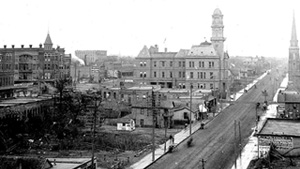From Proud Heritage, Vol. 1 by DCPA, not currently in print.
In 1843 Adolphus F. Gouhenant was taken from Agen, France in the middle of the night and escorted by armed guards to a small, damp cell in Toulouse. With no lights, no fire for warmth, and nothing but bread and water to sustain him, he sat in prison for 57 days. A correspondent for the Populaire, a Socialist newspaper, Gouhenant was charged with “plotting communism and heading up a secret organization.”
In the record of the trial “Proces du Comm unisme” by M. Cabet, Gouhenant is described as having “a facial expression that is hard and severe. His hair is long and curly, and he wears a blond beard. His forehead is clear and calm. His eyes are constantly moving, and they show artistic passion. He is quiet, but speaks like a man well educated; like a man who is constantly in thought.”
Adolph Gouhenant was 38 the year of the trial; when it was over, he packed up his wife, Elizabeth, and their son, Ernest, and came to Texas to start anew.
Gouhenant ‘s “artistic passion” led him to open The Arts Saloon, Dallas’ first art gallery and photography studio, which was located on the courthouse square. According to Charles DeMorse, a visitor to Dallas, this was the center of activity:
“M. Gouhenant, a gentleman of education and accomplishments who had come out with the first French emigration to the Cross Timbers, and after some vicissitudes incident to life in a strange land, and the fortunes of an enterprise, had settled himself in Dallas, teaching French and Spanish, painting of pictures and signs, and instruction upon half a dozen musical instruments, had constituted himself a decided feature of the place. At night, attracted by the lights, and the sound of the violin, we proceeded to the Saloon and found a dance in full operation, in which, besides the ladies and resident gentle men, were participating Maj. Arnold, the gentlemanly commandant of Ft. Worth, and Maj. Young, the Sutler for the post. We found the main room of the Saloon large enough for two sets one side was an honorable member of the legislature playing the violin assisted by Mons. Gouhenant. The Saloon itself was draped with flesh colored canvass, and pleasantly lighted, and to the best of my ability, I represented the City of Clarksville upon the dance floor. His honor, not caring to dance, enjoyed himself by mixing conversationally. This morning, Sunday School was held at the Arts Saloon, and subsequently, there was preaching at the same place. So my readers will perceive that the Arts Saloon hold’s no mean position at ‘The Three Forks’. During the morning, Mons. Gouhenant exhibited to us some specimens of his painting, both in oil and water colors, most of the later decidedly beautiful.”
(From an editorial which appeared on the front page of the Northern Standard on July 7, 1852.)
Gouhenant was well received in Dallas. In 1854, he was called to civic duty when he was appointed to serve with W. W. Peak, John Good, and others for a three-month period as city patrol for the Dallas precinct. His gallery also served as a temporary courthouse. Wherein, he once received $7.50 rent for a district court session that was held there.
Unfortunately, soon after that, he became involved with a series of lawsuits that plagued him throughout his remaining years in Dallas.
In 1855, Gouhenant went to Ft. Worth to set his son up in business. Upon his return, he discovered that Alexander Cockrell now owned his property. Believing that Adolph Gouhenant had abandoned his business, the sheriff sold his lot to satisfy creditors.
Gouhenant appealed the decision to the Texas Supreme Court, claiming the Saloon was his homestead and that the sale was illegal. The presiding Judge Hemphill reversed the decision and commented, “There is no serious doubt but that the lot had been the homestead … And it should be remembered that creditors have no claim on the homestead … He was a daguerrotypist, a wanderer by vocation … And it was proven that in persuit (sic) of his business, he had been absent on former occasions.”
He owned several other town lots, but they too seemed to be involved in litigation. That same year, he sued Joseph Anderson for trespassing and “destroying his lots by means of making bricks, kilns, etc. and burned same by making of such.” It seems Gouhenant was somewhat of an environmentalist and was preparing said lots for “cultivations as a flower and vegatable (sic) garden for which purpose he had hired at great expense skillful workmen for the sum of $200.00.”
Gouhenant was also involved in a malpractice suit, several disputes over estates, and in quarrels regarding the execution of a will or two. Although court records are incomplete, it .appears he won most of them. The last record of Adolph Gouhenant appears in the county tax records of 1866 where he was still paying taxes on several town lots. In the 1870s, the family name was changed to Gounah, which is how it remains today with descendants living in Houston and Dallas.
Family Tree: Adolphus F. Gouhenant married Elizabeth; Ernest Gouhenant married Sarah Boyd; Julia Gouhenant married James Barnett; Pauline Barnett married Samuel Downey; Carolyn Downey married Simon Selzer; Paula Selzer.
Some photographs that remain of early Dallas have been attributed to Adolph Gouhenant – street scenes, courthouse, etc. (They can be located at the Dallas Public Library.)
By Paula Selzer, Dallas


